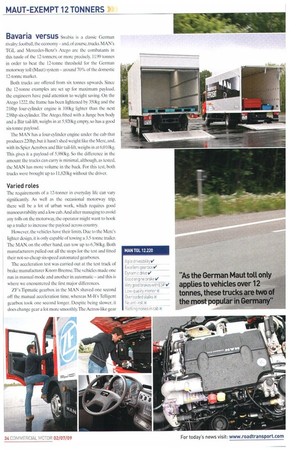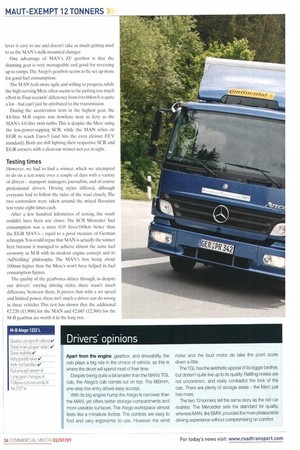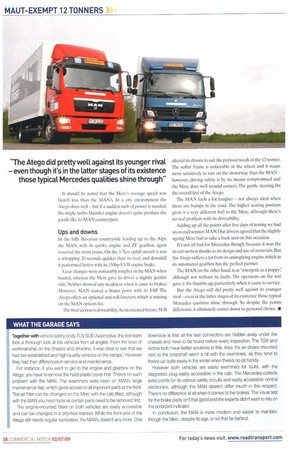MAUI-EXEMPT 2-TONNERS
Page 32

Page 34

Page 36

Page 38

If you've noticed an error in this article please click here to report it so we can fix it.
Which German truck-maker wilt take the crown?
Toll-friendly 12-tonners from MAN and Mercedes-Benz go head to head and despite similar performance levels and matctiing automatedsjx-speed transmissions, there are still quite a few difference,s between them,..
Words / images: Oliver Warns
Bavaria versus Swabia is a classic German rivalry: football, the economy — and, of course, trucks. MAN's TGL and Mercedes-Benz's Atego are the combatants in this tussle of the 12-tonners; or more precisely, 11.99 tonnes in order to beat the 12-tonne threshold for the German motorway toll (Maut) system — around 70% of the domestic 12-tonne market.
Both trucks are offered from six tonnes upwards. Since the 12-tonne examples are set up for maximum payload, the engineers have paid attention to weight saving. On the Atego 1222, the frame has been lightened by 350kg and the 218hp four-cylinder engine is 100kg lighter than the next 238hp six-cylinder. The Atego. fitted with a Junge box body and a Bar tail-lift, weighs in at 5,920kg empty, so has a good six-tonne payload.
The MAN has a four-cylinder engine under the cab that produces 220hp, but it hasn't shed weight like the Merc, and, with its Spier Aerobox and Bar tail-lift, weighs in at 6,010kg. This gives it a payload of 5,980kg. So the difference in the amount the trucks can carry is minimal, although, as tested, the MAN has more volume in the back. For this test, both trucks were brought up to 11,820kg without the driver.
Varied roles
The requirements of a 12-tonner in everyday life can vary significantly. As well as the occasional motorway trip, there will be a lot of urban work, which requires good manoeuvrability and a low cab. And after managing to avoid any tolls on the motorway, the operator might want to hook up a trailer to increase the payload across country.
However, the vehicles have their limits. Due to the Mere's lighter design, it is only capable of towing a 3.5-tonne trailer. The MAN, on the other hand, can tow up to 6,760kg. Both manufacturers pulled out all the stops for the test and fitted their not-so-cheap six-speed automated gearboxes.
The acceleration test was carried out at the test track of brake manufacturer Knorr-Bremse.The vehicles made one run in manual mode and another in automatic — and this is where we encountered the first major differences.
ZF's Tipmatic gearbox in the MAN shaved one second off the manual acceleration time, whereas M-B's Telligent gearbox took one second longer. Despite being slower, it does change gear a lot more smoothly.The Actros-like gear
lever is easy to use and doesn't take as much getting used to as the MAN's stalk-mounted changer.
One advantage of MAN's ZF gearbox is that the shunting gear is very manageable and good for reversing up to ramps. The Atego's gearbox seems to be set up more for good fuel consumption.
'Me MAN feels more agile and willing to progress, while the high-revving Merc often seems to be putting too much effort in. Four seconds' difference from 0 to 60km/h is quite a lot but can't just be attributed to the transmission.
During the acceleration tests in the highest gear, the 4.8-litre M-B engine was nowhere near as fiery as the MAN's 4.6-litre twin-turbo. This is despite the Mere using the less-power-sapping SCR, while the MAN relies on FOR to reach Euro-5 (and hits the even cleaner EEV standard). Both are still fighting their respective SCR and EGR corners, with a clear-cut winner not yet in sight.
Testing times
However, we had to lind a winner, which we attempted to do on a test route over a couple of days with a variety of drivers transport managers, journalists, and of course professional drivers. Driving styles differed, although everyone had to follow the rules of the road closely. The two contenders were taken around the mixed Bavarian test route eight times each.
After a few hundred kilometres of testing, the result couldn't have been any closer. The SCR Mercedes' fuel consumption was a mere 0.05 litres/100km better than the EGR MAN's equal to a good measure of German schnapps. You could argue that MAN is actually the winner here because it managed to achieve almost the same fuel economy as M-B with its modem engine concept and its 'AdNothing' philosophy. The MAN's box being about 100mm higher than the Merc's won't have helped its fuel consumption figures.
The quality of the gearboxes shines through, as despite our drivers' varying driving styles, there wasn't much difference between them. It proves that with a set speed and limited power, there isn't much a driver can do wrong in these vehicles. This test has shown that the additional €2,220 (11,900) for the MAN and €2,685 (f2,300) for the M-B gearbox are worth it in the long run. It should be noted that the Mere's average speed was k rn/h less than the MAN's. In a city environment the Atego does well — hut if a sudden rush of power is needed, the single-turbo Daimler engine doesn't quite produce the goods like its MAN counterpart.
Ups and downs
In the hilly Bavarian countryside leading up to the Alps, the MAN, with its quirky engine and ZF gearbox, again received the most praise. On the 3.7km uphill stretch it was a whopping 20 seconds quicker than its rival, and downhill it performed better with its 150hp EVB engine brake.
Gear changes were noticeably tougher in the MAN when loaded, whereas the Merc gave its driver a slightly gentler ride. Neither showed any weakness when it came to brakes. However. MAN scored a bonus point with its ESP. The Atego offers an optional anti-roll function, which is missing on the MAN options list.
'The final section is driveability. As mentioned before, M-B altered its chassis to suit the payload needs of the 12-tanner. The softer frame is noticeable at the wheel and it reacts more sensitively to ruts on the motorway than the MAN — however, driving safety is by no means compromised and the Mere does well around corners. The gentle steering fits the overall feel of the Atego.
The MAN feels a lot tougher — not always ideal when there are bumps in the road. The higher seating position gives it a very different feel to the Mere, although there's no real problem with its drivcability.
Adding up all the points after five days of testing we had an overall winner: MAN. Our drivers agreed that the slightly ageing Mere had to take a back seat on this occasion.
It's not all had for Mercedes, though, because it won the in-cab section thanks to its design and use of materials. But the Atego suffers a lot from its uninspiring engine, which in its automated gearbox has the perfect partner.
The MAN, on the other hand, is as "energetic as a puppy': although not without its faults. The operators on the test gave it the thumbs-up, particularly when it came to service.
But the Atego still did pretty well against its younger rival — even in the latter stages of its existence those typical Mercedes qualities shine through. So despite the points difference, it ultimately comes down to personal choice. •
















































































































































